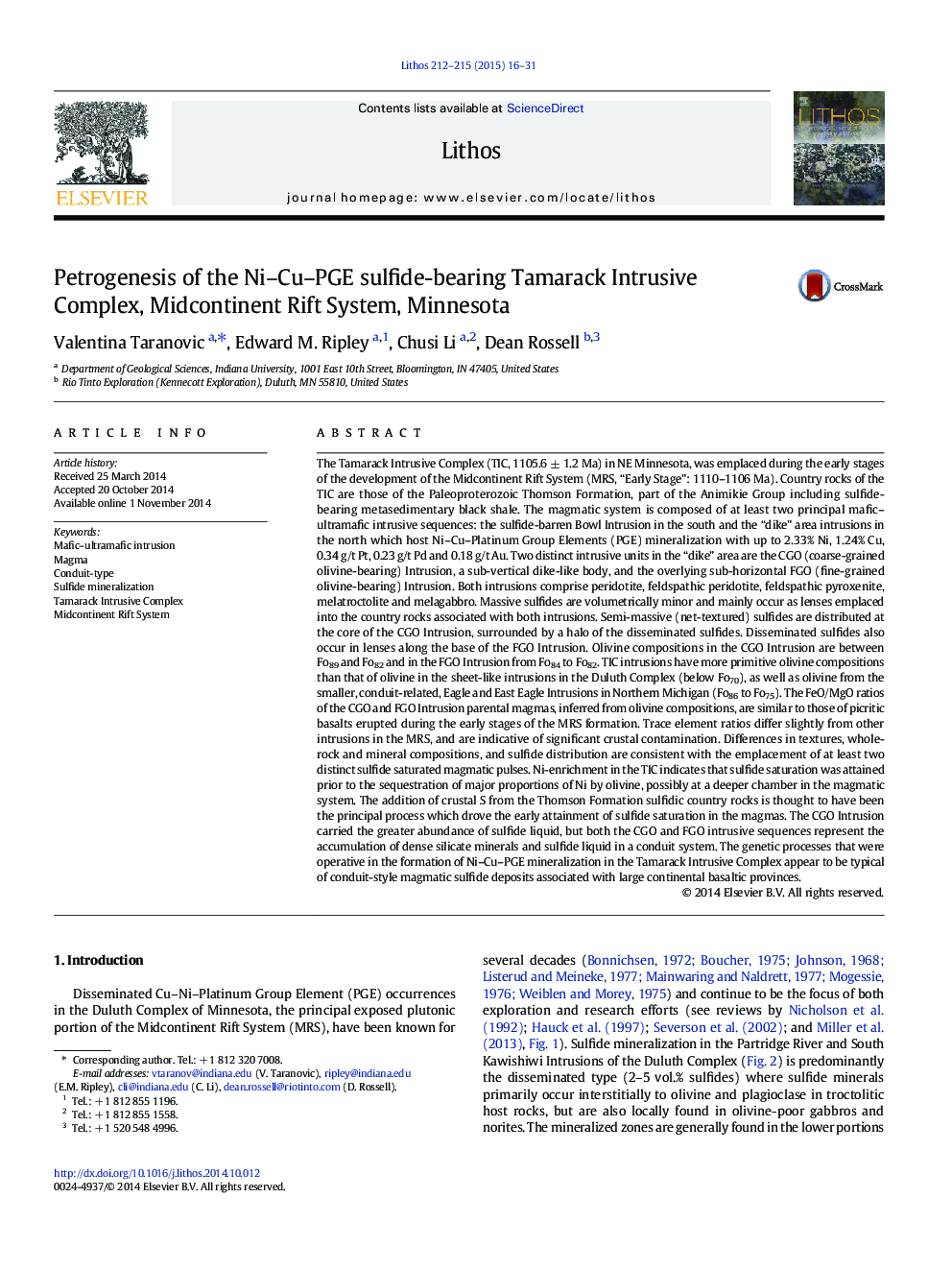| کد مقاله | کد نشریه | سال انتشار | مقاله انگلیسی | نسخه تمام متن |
|---|---|---|---|---|
| 4715786 | 1638669 | 2015 | 16 صفحه PDF | دانلود رایگان |

• We describe lithologies and sulfide mineralization of the Tamarack Intrusions.
• We model parental magma composition of Tamarack magmas.
• Multiple pulses of magma were emplaced in a conduit setting.
• Ni-rich sulfides resulted from an early sulfide saturation of magma.
• External S addition in deeper chambers drove the magma to sulfide oversaturation.
The Tamarack Intrusive Complex (TIC, 1105.6 ± 1.2 Ma) in NE Minnesota, was emplaced during the early stages of the development of the Midcontinent Rift System (MRS, “Early Stage”: 1110–1106 Ma). Country rocks of the TIC are those of the Paleoproterozoic Thomson Formation, part of the Animikie Group including sulfide-bearing metasedimentary black shale. The magmatic system is composed of at least two principal mafic–ultramafic intrusive sequences: the sulfide-barren Bowl Intrusion in the south and the “dike” area intrusions in the north which host Ni–Cu–Platinum Group Elements (PGE) mineralization with up to 2.33% Ni, 1.24% Cu, 0.34 g/t Pt, 0.23 g/t Pd and 0.18 g/t Au. Two distinct intrusive units in the “dike” area are the CGO (coarse-grained olivine-bearing) Intrusion, a sub-vertical dike-like body, and the overlying sub-horizontal FGO (fine-grained olivine-bearing) Intrusion. Both intrusions comprise peridotite, feldspathic peridotite, feldspathic pyroxenite, melatroctolite and melagabbro. Massive sulfides are volumetrically minor and mainly occur as lenses emplaced into the country rocks associated with both intrusions. Semi-massive (net-textured) sulfides are distributed at the core of the CGO Intrusion, surrounded by a halo of the disseminated sulfides. Disseminated sulfides also occur in lenses along the base of the FGO Intrusion. Olivine compositions in the CGO Intrusion are between Fo89 and Fo82 and in the FGO Intrusion from Fo84 to Fo82. TIC intrusions have more primitive olivine compositions than that of olivine in the sheet-like intrusions in the Duluth Complex (below Fo70), as well as olivine from the smaller, conduit-related, Eagle and East Eagle Intrusions in Northern Michigan (Fo86 to Fo75). The FeO/MgO ratios of the CGO and FGO Intrusion parental magmas, inferred from olivine compositions, are similar to those of picritic basalts erupted during the early stages of the MRS formation. Trace element ratios differ slightly from other intrusions in the MRS, and are indicative of significant crustal contamination. Differences in textures, whole-rock and mineral compositions, and sulfide distribution are consistent with the emplacement of at least two distinct sulfide saturated magmatic pulses. Ni-enrichment in the TIC indicates that sulfide saturation was attained prior to the sequestration of major proportions of Ni by olivine, possibly at a deeper chamber in the magmatic system. The addition of crustal S from the Thomson Formation sulfidic country rocks is thought to have been the principal process which drove the early attainment of sulfide saturation in the magmas. The CGO Intrusion carried the greater abundance of sulfide liquid, but both the CGO and FGO intrusive sequences represent the accumulation of dense silicate minerals and sulfide liquid in a conduit system. The genetic processes that were operative in the formation of Ni–Cu–PGE mineralization in the Tamarack Intrusive Complex appear to be typical of conduit-style magmatic sulfide deposits associated with large continental basaltic provinces.
Journal: Lithos - Volumes 212–215, January 2015, Pages 16–31